If your yews are old, have been shorn repeatedly so they have
little depth to their foliage layer, and have been allowed to creep
'way beyond their bounds, they may take a year or two to complete
recovery from a cutback.
We present these photos to help you decide whether you can wait
while old yews recover. Please note: We don't always wait when
plants make a slow comeback but in this situation it worked out
that way and we took the lesson as a bonus.
First, a four-image overview.
The whole story follows, with additional images.
Clockwise from upper left: August, the next April, very early
spring 30 months after the initial cut, and 30 months plus two
hours later.


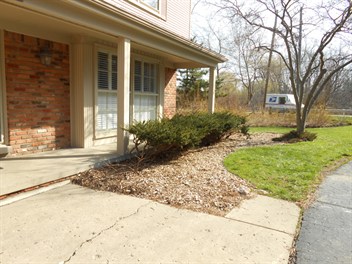
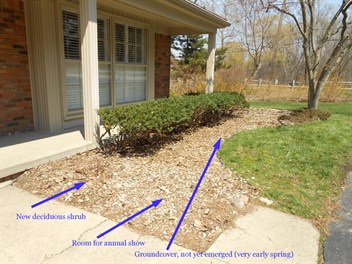
Step one: Decide to cut back.
August, year one.
We said to our client, "You're right, this front foundation
needs help. But rather than starting over with new plants let's see
how these well established yews respond to a cutback." So we cut
back hard, doing the work in late summer (mid-August) because
that's when we decided to deal with this problem.
Above, right: First, we cut back as far as the green shell
would permit.
Below: That was not enough -- even when cut back to their last
threads of green the shrubs would still hang over the walk and hide
the windows.
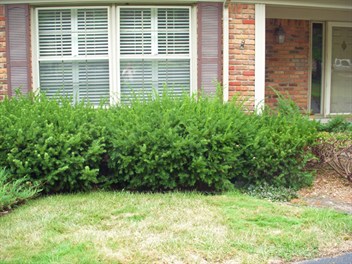
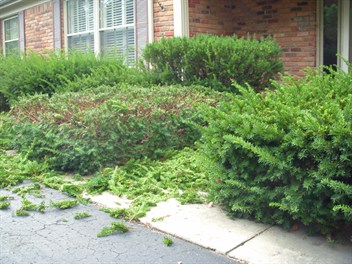
Below: So we cut them all back further.
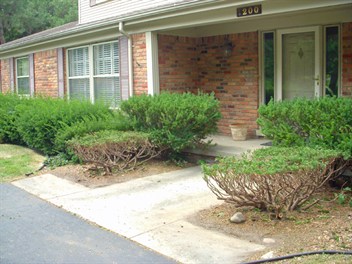
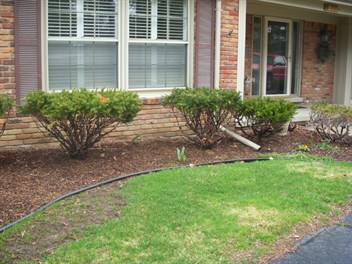
Why?! You might say. Those are as ugly in a new way as they were
when they were overgrown!
A trial cut is almost always worthwhile. It's no extra labor --
we must cut up the shrubs even if we dig them out. The only
difference is that if we wait for spring before we dig, we often
see gangbuster new growth. However, if the cutback yews produce
only a few new shoots a month after spring's sprung, and we don't
want to wait, then it's time to buy new and start over.
Step two: Wait.
Spring, seven months after the cut.
We knew that by late spring -- about a month after a yew's
normal first flush of growth -- we would see whether the shrubs
began to fluff out with lots of new
growth or planned to revive more slowly.
Most of these yews pushed out only enough new growth that first
spring to show us intent to come back.
Some were very slow. Conveniently, they were at the front walk.
Knowing we would not be able to remake the entire front foundation
at one time, we had decided to focus on the front walk. We dug out
the slow-pokes.
Still Step Two:
Spring, 19 months after the cut.
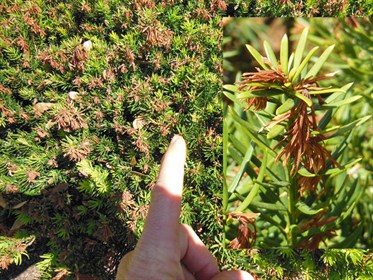
In year two after the cut, spring came earlier than it ever had.
The warmth fooled even established native plants to leaf out a
month ahead of schedule.
On the yews, lots of dormant buds sprouted.
Then, a freeze came. It killed all the foliage on many plants,
including most of the new growth on these yews. It swamped us with
work in every garden -- protecting, replacing, cutting back damage.
So the remaining yews stayed in place, managing to pick up their
growing pace only a little.
Summer, 23 months after the cut.
Cool weather and lots of rain in early summer coaxed these and
other yews into a pretty fine second flush of growth. We said,
"Well then, you're beginning to look good," and left them to it,
simply making some cuts to thin more of the densest branched
sections.
Unfortunately, the good times didn't last. That summer set
records as the hottest ever for the continent. Some areas, ours
included, suffered drought as well. This fried many plants,
including the new shoots of yews everywhere. Ma Nature cut back our
trial yews a second time that year.
Meanwhile, the work made by freakish weather tied us up so these
yews remained in place. We simply clipped to remove all the dead
tips.
Step three: Spring, 30 months after the cut.
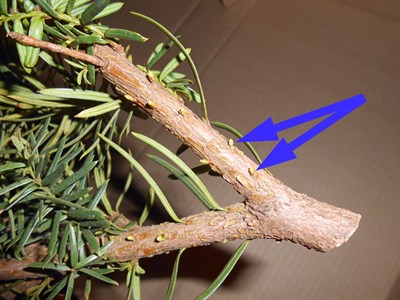
Spring came late but when it did we said, "How about that!"
Dormant buds appeared in abundance along the branches.
(Right.)
We cut to keep the shrubs within bounds and made more thinning
cuts to encourage dormant buds even lower on their ankles. By the
end of this summer -- ongoing as we write -- these will be fine
specimens and we'll update this photo story.
Below, early spring, 30 months after cutback.
Below, left: Finally becoming acceptably thick. We've
pruned the left-hand shrub. WE took from it all the branches on the
lawn in the foreground.
Below, right: After we pruned the yews per normal annual
procedure. The aims are to keep them below the windows and thin
them to encourage growth from those ugly ankles.
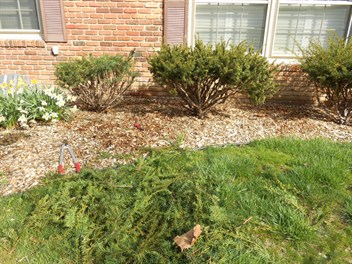
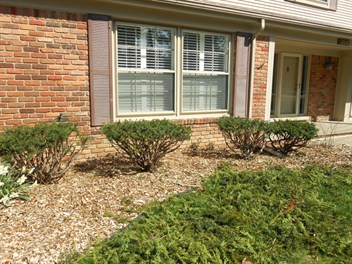
Above, right: If these shrubs seem too bare, look again at
that low windowsill, and check this example of what we know
plants can do when we cut back hard regularly with an eye to keep a
plant small and also dense.
Below: For comparison. Here they are again when just cut back, for
comparison to the photos above that were taken 30 months later.
Notice below that the shrubs' foliage was at and above windowsill
level. The thinning we did during the otherwise-unproductive
intervening years promoted foliage lower on the stems. By fall they
will probably be full to the ground with leaves and buds.

Prune well after cutback
One last note: Don't fall back into shearing-only after you
rejuvenate or replace yews. Be sure to begin right away with the right kind of
pruning whenever they reach the height or width you can
allow.